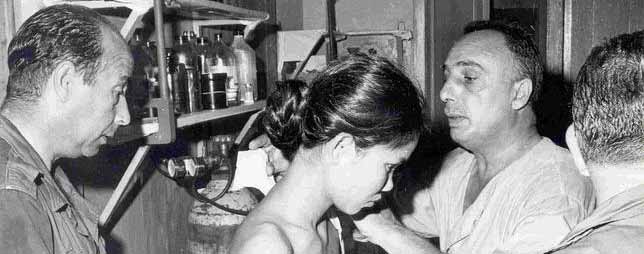Source:ABC
With the edition of a book, the Ministry of Defense recovers the history of the more than 50 military doctors and sanitarians who were deployed in the conflict between 1966 and 1971
Retired General Antonio Velázquez admits having seen all the films of the Vietnam War. And he is clear in which is the one that most closely resembles what he experienced as a member of the first foreign medical mission of the modern Spanish military. Because before the Balkans, Afghanistan, Mali and so many other settings where the Armed Forces have been deployed … there was also Vietnam.
Twelve were the soldiers of the first contingent that was deployed in September 1966 with a “confidential” mission: to provide aid to civilians – ultimately also military, South Vietnamese and communist Vietcong guerrillas, without distinction, and also Americans – in an old hospital in Gò-Công, a small city in the Mekong Delta, of about 30,000 inhabitants and located 45 kilometers from Saigon, current Ho Chi Minh.
In total, more than fifty doctors and paramedics passed through Vietnam as part of the international deployment backed by the United States. In the Spanish scenario until October 1971. Now, the Ministry of Defense has unearthed the history of those medical military pioneers with the edition from the book “Saving lives in the Mekong Delta”, by the historian José Luis Rodríguez Jiménez, professor at the Rey Juan Carlos University.
With the military agreements signed in 1953 between Eisenhower’s Uinted States and Franco’s Spain, a Spanish contribution to the request made by the Johnson administration was logical. “Washington applied through the Free World Military Assistance Office. Once received in Madrid, in April 1966, the General Command HQ sent confidential documents to the General Captaincies (regional military commads). In Madrid, they did not think of civilian doctors as in other countries, but of the Army’s Military Health Corps”, explains Rodríguez Jiménez.
It was such a secret mission that the deployed soldiers, surprised that their work was hardly ever discussed, even sent a note to ABC that appeared published on New Year’s Eve in 1966: “It was titled ‘Spaniards in Gò-Công’, and in the text was omitted that they were military. Part of the note read like this: ‘the task is hard, and the sick and injured are many, the means are not very abundant. Vietnam is at war, Lord! […] In Gò Công, a small town in South Vietnam, is where these twelve Spaniards are doing some good’.”
The consultations included tuberculosis , mutilated, victims of mines, napalm bombings or traffic accidents, many mothers with children suffering from diphtheria, typhoid fever, malaria, intestinal parasites, dysentery, and diarrhea. A demanding job for military medical personnel who, as the then Lieutenant Velázquez acknowledges, “had not received any kind of special training. Simply, our already acquired medical knowledge. Well, they gave us a decalogue of the good medical officer, on customs and traditions in the area.”

Spanish soldiers at the entrance of the mission in Gò-Công
The now-retired general remembers perfectly how at the age of 26 he undertook the adventure of his life: “Madrid-Rome-Karachi-Bangkok-Saigon. That was the air route we followed, of course, dressed in plain clothes. We went as criminals and we returned as criminals. As if that did not have to be known […] In the pediatric ward the children died like flies.”
These soldiers wore the American fatigues during working hours, with Spanish badges, and they were allowed to wear the Spanish uniform during rest time. The Spanish experienced war situations, of course. “Especially in February 1968, during the Tet offensive, when the Vietcong carried out attacks throughout the southern area, even entering Saigon and besieging the US embassy”, explains the author of the book published by the Defense Ministry about these 50 Spanish military soldiers forgotten in Spain when dealing with the Vietnamese conflict or missions abroad.

Decorations in Vietnam for the Spanish military
“The Vietcong guerrillas never attacked the Spanish personnel, but other medical teams suffered casualties and this type of news spread like wildfire. To this must be added that, although the enemy soldiers used to appreciate the help provided to civilians and also to the wounded communist guerrillas, the trips had the added risk of mines on the dirt roads.” Among the many lessons learned that the Spanish military acquired is, for example, the evacuation of combat-wounded with helicopters. The so-called “Medevac”, so widely used now in Afghanistan.
“Platoon”. That is the film that best reflects the Vietnam that we Spaniards experienced. That was the time when the Americans patrolled the villages in groups of 15 and 20 soldiers. “‘Apocalypse Now’ seemed very fanciful to me”, recalls retired General Velázquez, one of the pioneers of Spanish military missions abroad. On a “confidential” mission.
Share this article
On This Day
- 1503 Battle of Cerignola (Italy).
- 1522 Santiago de Cuba is granted the city status by Carlos I.
- 1589 Margarita de Saboya is born.
- 1611 Archbishop Miguel de Benavides founded the University of St Thomas in Manila.
- 1777 José Primo de Rivera, Hero of the Sieges, was born in Algeciras.
History of Spain
26 August 2020
27 January 2021
Communism: Now and Then
23 December 2022
28 July 2021






